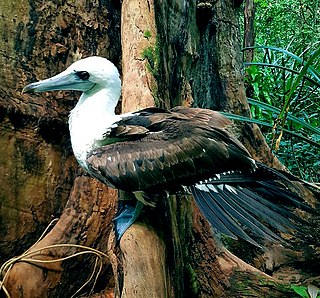 W
WAbbott's booby is an endangered seabird of the sulid family, which includes gannets and boobies. It is a large booby, smaller than gannets, and is placed within its own monotypic genus. It was first identified from a specimen collected by William Louis Abbott, who discovered it on Assumption Island in 1892.
 W
WThe northern royal albatross or toroa, Diomedea sanfordi, is a large seabird from the albatross family. It was split from the closely related southern royal albatross as recently as 1998, though not all scientists support that conclusion and some consider both of them to be subspecies of the royal albatross.
 W
WThe southern royal albatross is a large seabird from the albatross family. At an average wingspan of above 3 m (9.8 ft), it is one of the two largest species of albatross, together with the wandering albatross. Recent studies indicate that the southern royal albatross may, on average, be somewhat larger than the wandering albatross in mass and have a similar wingspan, although other sources indicate roughly similar size for the two species and the wandering species may have a larger average wingspan in some colonies.
 W
WThe Banks flying fox is a species of megabat in the family Pteropodidae. It is endemic to Vanuatu. Its natural habitats are subtropical or tropical dry forests and subtropical or tropical swamps. These small fruit bats are about 15 cm. long with grey and brown on its head and back with a yellow-orange neck and yellow-gray bellies. Its diet consists of coconut flowers and Vaveli trees fruit since its home is tropical.
 W
WThe New Georgian monkey-faced bat is a recently described species of megabat endemic to the Solomon Islands, more specifically New Georgia and Vangunu Islands. It is presumably extinct on Kolombangara Island, and remaining population on other islands are threatened by habitat loss and hunting. Consequently, it is considered vulnerable by IUCN. In 2013, Bat Conservation International listed this species as one of the 35 species of its worldwide priority list of conservation.
 W
WThe Bougainville monkey-faced bat is a megabat endemic to Bougainville Island of Papua New Guinea and Choiseul Island of the Solomon Islands in Melanesia. It inhabits mature forests in upland areas, within the Autonomous Region of Bougainville and Bougouriba Province.
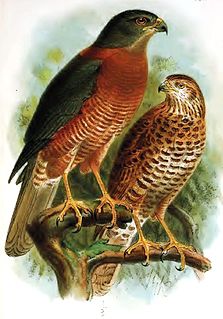 W
WThe Christmas goshawk or Christmas Island goshawk is a bird of prey in the goshawk and sparrowhawk family Accipitridae. It is a threatened endemic of Christmas Island, an Australian territory in the eastern Indian Ocean.
 W
WDavid's echymipera, or David's spiny bandicoot, is a species of marsupial in the family Peramelidae. It is found on the island of Kiriwina, in the Trobriand Islands of Papua New Guinea, and may be present on other nearby islands also.
 W
WThe dingiso, also known as bondegezou, is a species of tree-kangaroo endemic to Papua Province central on New Guinea island, in northeastern Indonesia.
 W
WThe giant bandicoot is a species of marsupial in the family Peramelidae endemic to Papua New Guinea. Its natural habitat is subtropical or tropical dry forests.
 W
WThe Guadalcanal monkey-faced bat is a megabat endemic to Solomon Islands. It is listed as an endangered species. In 2013, Bat Conservation International listed this species as one of the 35 species of its worldwide priority list of conservation.
 W
WThe kagu or cagou is a crested, long-legged, and bluish-grey bird endemic to the dense mountain forests of New Caledonia. It is the only surviving member of the genus Rhynochetos and the family Rhynochetidae, although a second species has been described from the fossil record. Measuring 55 cm (22 in) in length, it has pale grey plumage and bright red legs. Its 'nasal corns' are a unique feature not shared with any other bird. Almost flightless, it spends its time on or near the ground, where it hunts its invertebrate prey, and builds a nest of sticks on the forest floor. Both parents share incubation of a single egg, as well as rearing the chick. It has proven vulnerable to introduced predators and is threatened with extinction.
 W
WThe Mariana fruit bat, also known as the Mariana flying fox, and the fanihi in Chamorro, is a megabat found only in the Mariana Islands and Ulithi. Habitat loss has driven it to endangered status, and it is listed as threatened by the US Fish and Wildlife Service. Poachers and food hunters, other animals, and natural causes have led to the decline.
 W
WOrnithoptera croesus, the Wallace's golden birdwing, is a species of birdwing butterfly found in northern Maluku in Indonesia.
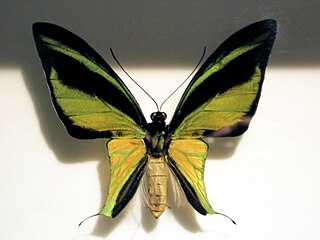 W
WOrnithoptera meridionalis, the southern tailed birdwing, is the smallest species of the genus Ornithoptera. It is known from a handful of localities in southeast Papua, New Guinea and several localities along the south coast of Irian Jaya.
 W
WThe Pacific sheath-tailed bat or Polynesian sheath-tailed bat is a species of sac-winged bat in the family Emballonuridae found in American Samoa, Fiji, Guam, Micronesia, Palau, Samoa, Tonga, and Vanuatu. Its natural habitat is caves. In 2013, Bat Conservation International listed this species as one of the 35 species of its worldwide priority list of conservation. It is threatened by habitat loss. There are estimated to be approximately 500 individuals of E. s. rotensis, a subspecies of the highly fragmented Emballonura semicaudata. Due to its dependence on forests and caves for roosting, it is known to roost in only three caves currently, E. s. rotensis is vulnerable to changes in the surrounding demographic and environmental changes reflective of indirect impacts caused by invasive species, in this case goats. Goats limit the carrying capacity of E.s. rotensis.
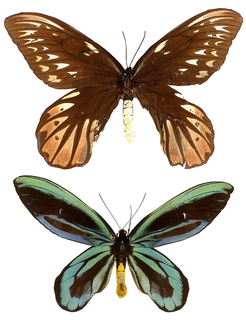 W
WOrnithoptera alexandrae, the Queen Alexandra's birdwing, is the largest species of butterfly in the world, with females reaching wingspans slightly in excess of 25 cm to 28 cm. This birdwing is restricted to the forests of the Oro Province in eastern Papua New Guinea.
 W
WSamoana diaphana, one of several species also known as the Moorean viviparous tree snail or the Polynesian tree snail, is a species of tropical, air-breathing land snail, a terrestrial, pulmonate, gastropod mollusk in the family Partulidae. This species is endemic to French Polynesia.
 W
WThe Seram bandicoot, also known as the Seram Island long-nosed bandicoot, is a member of the order Peramelemorphia that is endemic to the island of Seram in Indonesia. It is the only species in the genus Rhynchomeles.
 W
WThe speartooth shark is an extremely rare species of river shark, belonging to the family Carcharhinidae. It inhabits coastal marine waters and tidal reaches of large tropical rivers in northern Australia and New Guinea. Despite being a member of the river shark genus, it is also found in near-shore marine waters, favoring highly turbid environments over a wide range of salinities. This robustly built, gray-colored shark is characterized by a short and broad snout, tiny eyes, a relatively large second dorsal fin, and a black blotch beneath each pectoral fin near the tip. Another identifying trait is its teeth, which are large, triangular, and serrated in the upper jaw and narrow, spear-like, and serrated only near the tips in the lower jaw. Adults grow to about 2.6 m (8.5 ft) long.
 W
WThe zebra shark is a species of carpet shark and the sole member of the family Stegostomatidae. It is found throughout the tropical Indo-Pacific, frequenting coral reefs and sandy flats to a depth of 62 m (203 ft). Adult zebra sharks are distinctive in appearance, with five longitudinal ridges on a cylindrical body, a low caudal fin comprising nearly half the total length, and usually a pattern of dark spots on a pale background. Young zebra sharks under 50–90 cm (20–35 in) long have a completely different pattern, consisting of light vertical stripes on a brown background, and lack the ridges. This species attains a length of 2.5 m (8.2 ft).
 W
WThe Temotu flying fox is a species of flying fox in the family Pteropodidae. It is endemic to the Solomon Islands. It is threatened by habitat destruction due to subsistence agricultural practices, as well as natural disasters such as tropical cyclones. Due to its imperiled status, it is identified by the Alliance for Zero Extinction as a species in danger of imminent extinction. In 2013, Bat Conservation International listed this species as one of the 35 species of its worldwide priority list of conservation.
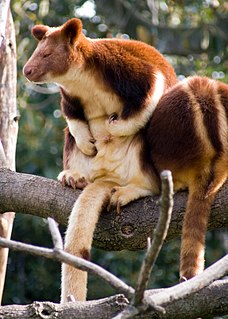 W
WGoodfellow's tree-kangaroo also called the ornate tree-kangaroo, belongs to the family Macropodidae, which includes kangaroos, wallabies and their relatives, and the genus Dendrolagus, with eleven other species. The species is native to the rainforests of New Guinea, and the border of central Irian Jaya in Indonesia. Under the IUCN classification, the species is listed as Endangered, which is a result of overhunting and human encroachment on their habitat. It is named after British zoological collector Walter Goodfellow.
 W
WMatschie's tree-kangaroo, also known as the Huon tree-kangaroo is a tree-kangaroo native to the Huon Peninsula of northeastern New Guinea island, within the nation of Papua New Guinea.
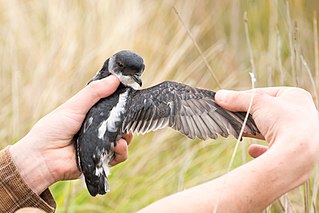 W
WThe Whenua Hou diving-petrel is a highly endangered diving petrel endemic to New Zealand. The species was first described by Johannes H. Fischer et al. in 2018. While formerly considered a unique population of the South Georgia diving petrel, differences in habitat preference and analyses of phenotypic differentiations indicates that it is a distinct species. Only one extremely small population currently exists, breeding on the predator-free Whenua Hou island. There, it displays the unique nesting practice of burrowing into the sand dunes overlooking Sealers Bay, much unlike the South Georgia diving petrel, which nests on rocky slopes or flat land.
 W
WThe Woodlark cuscus is a species of marsupial in the family Phalangeridae endemic to Papua New Guinea, specifically on Madau and Woodlark Island, a part of the Milne Bay Province of Papua New Guinea. It happens to be the largest mammal living on Woodlark Island but it is also found on the neighboring island of Alcester, 70 kilometers south of Woodlark Island.